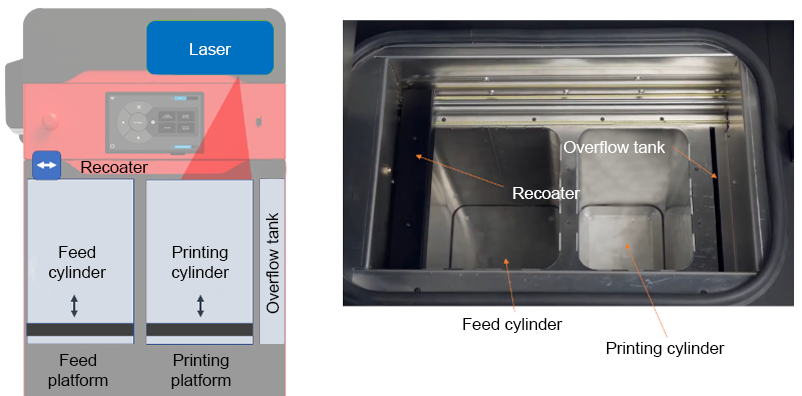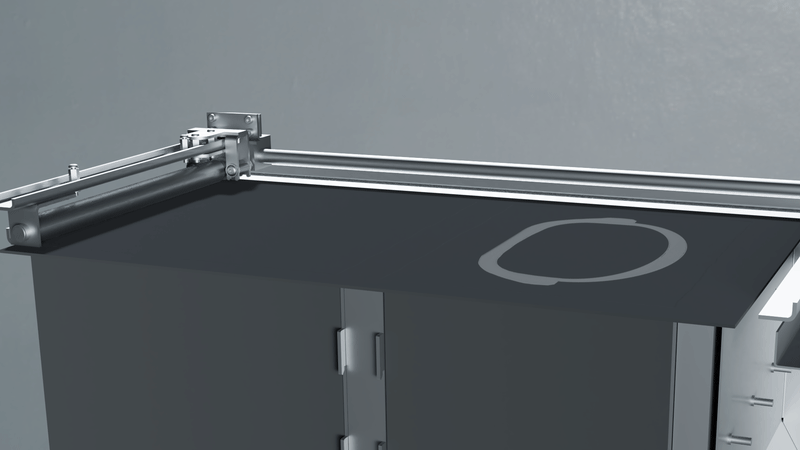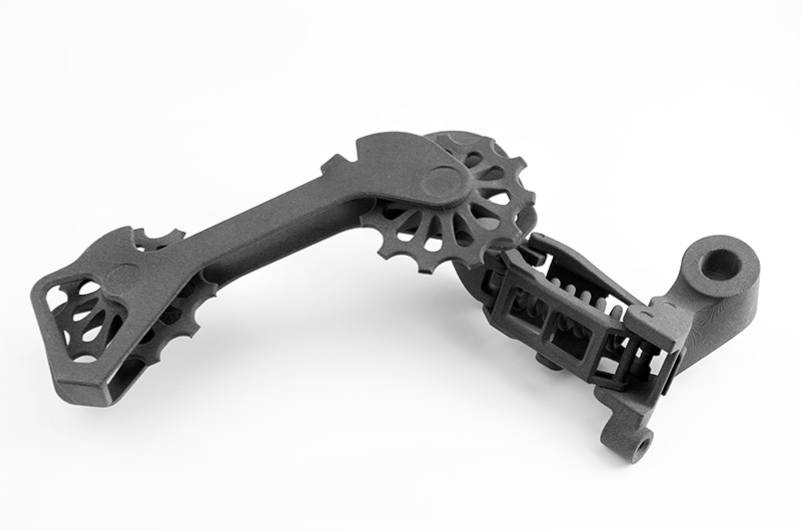
SLS technology is a powder bed-based additive manufacturing technology. It is based on sintering small plastic powder particles layer by layer through the application of a scanning laser.
Parts of SLS 3D printers
SLS printers have several parts:

Image 1: Parts of an SLS 3D printer. Source:
- Feed cylinder: This is the tank that contains the powder required for printing. It has a mobile platform in charge of exposing the powder so that it can be transferred to the printing area.
- Printing cylinder: This is the area where the parts will be formed. It has a mobile platform on which the parts will begin to be manufactured.
- Overflow tank: This is the tank where the excess powder dragged by the recoater is stored.
- Recoater: This is the element responsible for transferring the powder from the feed cylinder to the printing cylinder and thus forming the layers. The excess powder ends up in the overflow tank.
- Laser: This is the device responsible for selectively sintering the powder. It does this by means of a scanning process where the movement can be by means of a gantry movement system (slower) or by means of a galvo (faster).
Printing process
At the start of printing, the feeding platform is at the lowest point with the cylinder full of powder ready to print, while the printing platform is at the highest point with an empty cylinder. Once printing starts, the process is as follows:
- The printing platform is lowered a distance equivalent to the layer height, while the feeding platform is raised exposing a quantity of powder.
- The recoater travels from one end to the other, transferring and distributing the exposed powder from the infeed bed to the printing bed, thus forming the first layer. The excess powder transferred by the recoater is poured into the overflow tank at the end of its travel.
- The laser selectively sweeps over the formed layer, solidifying the part.
- The process is repeated for each of the layers forming the part.

Image 2: Operation of an SLS 3D printer. Source:
Advantages of SLS 3D printing
SLS 3D printing has a number of characteristics that make it stand out when it comes to producing functional components.
- High precision: SLS 3D printing is, together with SLA technology, one of the most precise of all additive manufacturing technologies. The accuracy in the XY plane is between 30 and 50 um.
- Self-supporting technology: Like other powder bed technologies, SLS technology does not require the use of supports in any case, which allows any geometry to be obtained, however complex it may be. This, together with the high precision, makes it possible to print functional assemblies already assembled.

Image 3: Functional assembly printed using SLS technology. Source: Sinterit.
- Isotropy: SLS 3D printing technology provides parts with high isotropy of properties in all directions. The ratio between the X, Y and Z axes is close to 1, so parts behave similarly regardless of where loads are applied.
- Good finishes: Although SLS 3D printed parts have some surface roughness, the finish is superior to other technologies, such as FDM, which makes it suitable for the production not only of prototypes, but also of final parts.
- Availability of technical materials: The standard material used in SLS technology is polyamide, a technical plastic with good mechanical and thermal behavior. In addition, there are other options such as thermoplastic composites, polypropylene or multiple thermoplastic elastomers.
This guide discusses concepts in a general way and does not focus on a particular brand or model, although they may be mentioned at some point. There may be important differences in calibration or adjustment procedures between different makes and models, so it is recommended that the manufacturer's manual be consulted before reading this guide.












